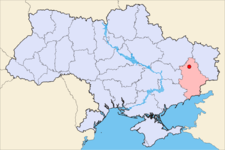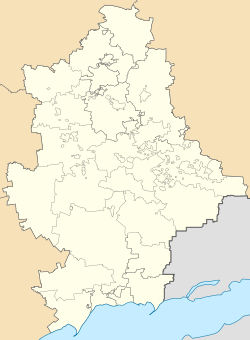Kramatorsk
|
Kramatorsk Краматорськ |
|||
|---|---|---|---|
| City | |||

Main square of Kramatorsk
|
|||
|
|||
 Kramatorsk on the map of Ukraine |
|||
| Kramatorsk on the map of Donetsk Oblast | |||
| Coordinates: 48°43′N 37°32′E / 48.717°N 37.533°ECoordinates: 48°43′N 37°32′E / 48.717°N 37.533°E | |||
| Country |
|
||
| Oblast |
|
||
| Founded | 1868 | ||
| City status since | 1932 | ||
| Area | |||
| • City | 117.1 km2 (45.2 sq mi) | ||
| Population (2013) | |||
| • City | 164,283 | ||
| • Density | 583/km2 (1,510/sq mi) | ||
| • Metro | 197,752 | ||
| Time zone | EET (UTC+2) | ||
| • Summer (DST) | EEST (UTC+3) | ||
| Postal code | 84300-84390 | ||
| Area code(s) | +380 626(4) | ||
| Website | www |
||
Kramatorsk (Ukrainian: Краматорськ, Kramators'k) is a city of oblast significance located at the northern portion of Donetsk Oblast, in eastern Ukraine. Since October 11, 2014 Kramatorsk has been the provisional seat of Donetsk Oblast, following the events surrounding the War in Donbass.
The city is located on the banks of the Kazennyi Torets River which is a right tributary of the Siversky Donets. Population: 164,283 (2013 est.). It is an important industrial and mechanical engineering centre in Ukraine. At various periods, Kramatorsk was a place of residence for a number of notable people including Leonid Bykov, Joseph Kobzon and the youngest person to ever become FIDE World Champion Ruslan Ponomariov.
Kramatorsk and its city municipality is located between Sloviansk Raion and Kostiantynivka Raion and along with its centers is part of a major urban agglomeration in the region.
Kramatorsk has a population of over 164,700 inhabitants (2013) and has a metropolitan area of over 197,000 inhabitants (2013). As of the Ukrainian Census of 2001:
The city grew from a settlement by a small railway station in 1868 into a major urban settlement in the north of Donetsk Oblast with several heavy machine production facilities. It was occupied by Nazi Germany between 27 October 1941 and 5 February 1943 and again between 27 February 1943 and 6 September 1943.
Between 1980 and 1989, several people were exposed to a radiological source in one of the apartment buildings, resulting in 6 deaths and at least 17 cases of radiation sickness.
...
Wikipedia



